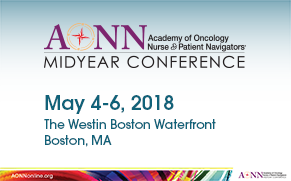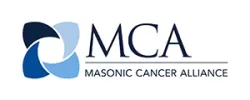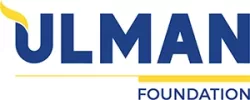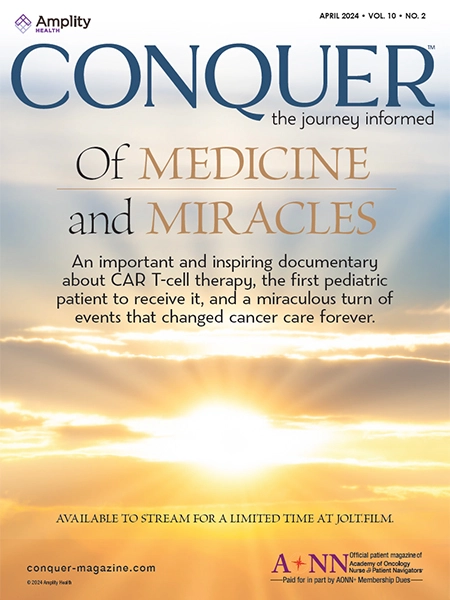Attendees of the Academy of Oncology Nurse & Patient Navigators (AONN+) Midyear Conference enjoyed a fun- and information-filled 3 days in Boston, MA. The conference, which took place on May 4-6, brought together hundreds of oncology navigators from all over the country.
During the 3-day event, attendees had the opportunity to learn about some of the hottest topics in oncology navigation, from the groundbreaking AONN+ standardized navigation metrics to integrative therapies to genetics and genomics testing. This year’s event also provided qualified attendees the opportunity to enhance their careers and take the AONN+ Oncology Nurse Navigator–Certified Generalist™ (ONN-CG™), Oncology Patient Navigator–Certified Generalist™ (OPN-CG™), and Oncology Nurse Navigator–Certified Generalist Thoracic™ (ONN-CG[T]™) Certification exams. Information about upcoming certification exams, including tips on how to prepare, is available on the AONN+ website.
If you weren’t able to attend the Midyear Conference, AONN+ proudly offers you the opportunity to keep up with the insightful sessions through our event app. If you haven’t yet, install the AONN+ Midyear Conference app on your smartphone or tablet, and download presentation slides from the sessions.

Pilot Study Aims to Gain Insight into Navigation Program Implementation, Metrics
The creation of 35 national Evidence-Based Standardized Navigation Metrics in 2016 filled a void in the navigation field, providing for the measurement of patient experience (PE), clinical outcomes (CO), and business performance or return on investment (ROI) among oncology navigation programs. The authors of the metrics, members of the Academy of Oncology Nurse & Patient Navigators (AONN+) Standardized Metrics Task Force, are seeking to make the metrics even more meaningful by conducting a first-of-its-kind, national pilot study on the measures and their use.
Task force members Tricia Strusowski, MS, RN, and Elaine Sein, RN, BSN, hosted a session to update AONN+ members on the metrics initiative and introduce them to the soon-to-launch study.
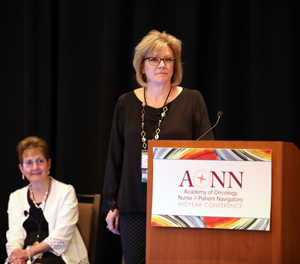
Checking in with attendees about whether their navigation programs are making use of the metrics, how the process has been working, and what, if any, barriers have been encountered, the task force members pointed out that it’s important for navigators to understand that participating in data collection, analytics, and outcomes reporting is not an added responsibility, but rather an existing part of the navigator’s role.
Knowledge of PE, CO, and ROI is not only critical for navigators, however; it is also imperative for key stakeholders like administrators and physicians to ensure the successful implementation of oncology navigation programs. These key stakeholders should also be engaged in program deployment and operations. Administrators, in particular, play an important role in the success of navigation programs, as they must be able to provide justification for the programs’ very existence by quantifying ROI for them, according to the task force members.
Entitled “National Evidence-Based Oncology Navigation Metrics: Multisite Exploratory Study to Demonstrate Value and Sustainability of Navigation Programs,” the collaborative effort among AONN+, Chartis Oncology Solutions, and the American Cancer Society is aimed at evaluating the validity and readability of 10 selected navigation metrics; gaining insight into the barriers and challenges encountered during navigation program implementation; and creating best practices to elevate navigation services and garner support for advancing the delivery of patient-centered care.
Through a process that includes protocol development and institutional review board approval; pilot site selection; implementation; analysis; and publication, the researchers will seek to attain the following objectives:
- Implementation of metrics and reporting of outcomes with data analysis
- Establishment of evidence-based, national standardized navigation benchmarks
- Navigation research to validate sustainability and value of navigation
- Identification of navigation best practices and lessons learned
- Creation of a centralized navigation metrics database and repository.
Secondary objectives are to identify challenges and barriers—from both clinical and information technology perspectives—and to develop, in collaboration with the American Cancer Society, a Navigation Metrics Implementation Tool Kit from the study’s findings.
The 8 sites from which the researchers will gather data include 2 National Cancer Institute–designated academic medical centers, 2 Commission on Cancer–accredited community-based cancer programs, 2 freestanding physician practices that participate in the Oncology Care Model, and 2 basic cancer programs that have no metrics or reporting methods in place.
Criteria for inclusion in the study were AONN+ membership, analytic cases numbering 750 or greater, a minimum of 2 navigators employed at the study site, support from the institution or physician practice, and active participation in selected national accreditation programs, in addition to organizational requirements for participation.
Through training and tool utilization—including use of NAVmetrics™, an iCloud-based business intelligence product—site visits, weekly calls, and data quality checks, the 8 study sites will capture and report data to achieve the study’s desired outcomes.
The task force members closed by presenting case studies of institutions that have employed the navigation metrics, showing the value of these metrics in evaluating the success of navigation programs.
Role of Navigator Can Be Key in Opening Door to Clinical Trials for Patients
The role of the patient navigator is multifaceted and spans the entire continuum of care, encompassing screening, diagnosis, treatment, and survivorship or end-of-life care. In a session on research and clinical trials, Lucy Gansauer, MSN, RN, ONC, CCRP, and Lavinia Dobrea, RN, MS, ONC, discussed yet another dimension of the navigator’s role—that of facilitating patient awareness of, and access to, clinical trials.

The National Comprehensive Cancer Network encourages participation in clinical trials for patients with cancer, stating that clinical trials provide the optimal management of these patients. Thus, the session speakers said, it is imperative for navigators to ensure that every patient is considered for trial eligibility, and if eligible, is offered the opportunity to participate; is educated on all options to make an informed decision, including informed refusal; and feels empowered enough to ask, “Is there a trial for me?”
Although navigators may not have research training, they can play a pivotal role in introducing patients to the concept of clinical trials. According to the speakers, navigators can normalize the idea of participating in a clinical trial for patients. This is important, because if the first time patients hear about clinical trials is from a provider, the possibility exists that they will feel too overwhelmed, intimidated, or lacking in understanding to ask questions. Navigators’ unique role as trusted patient advocates makes them well-positioned to inform patients that clinical trials are a viable treatment option that their physicians are likely to discuss with them.
A great way to broach the subject of clinical trials with patients is to ask them what they have heard about the studies. From there, navigators can begin answering questions and dispelling any falsehoods and myths that have made their way into the patients’ belief systems, the speakers said. For example, concerns about randomization can be addressed with an analogy as simple as that of childbirth—one doesn’t know whether it will result in a girl or a boy. Conversely, they warned, do not use the analogy of a coin toss to explain randomization, as it carries the connotation of a winner and a loser. To address potential fears about receiving placebo instead of the study drug, navigators can assure patients that participation in a clinical trial means they will always receive treatment equal to or better than the current standard of care.
Patient barriers to clinical trials largely mirror the obstacles they face in receiving standard care, which means the role of the navigator in overcoming these hurdles for clinical trials is similar to their current functions in that regard. In both cases, barriers include financial issues faced by uninsured, underinsured, unemployed, or low-income patients; transportation; fragmented care; low educational levels; low health literacy; and lack of comfort level in communicating with the healthcare team.
Navigators can further normalize, and encourage patients to participate in, clinical trials by expressing hope to the patient that he/she will be able to be matched with an appropriate trial, by explaining that participation in a trial will result in closer monitoring of their condition, and by informing patients that they will also benefit from being assigned a research nurse as a trial participant.
Explaining the purpose of clinical trials can also help patients to understand their value, the speakers said. This includes telling patients that their participation would afford them early access to potentially promising new therapies—often gleaned from the building blocks of standard treatments—and that these therapies are meant to improve on the current standard of care.
Navigators also play a role in screening patients for clinical trial enrollment, which consists of reviewing pathology reports and discussing patient cases in multidisciplinary conferences, during which navigators can impart patient information that is valuable to both the physician and the research nurse, the speakers explained. In addition, navigators can support research nurses by helping to coordinate lab tests to determine study eligibility, they said.
The navigator’s role in facilitating clinical trials doesn’t end once a patient is enrolled. As the healthcare team member who is often first to become aware of adverse events that patients are experiencing, navigators can communicate these to the research nurse.
Free resources from the National Cancer Institute, CancerCare, and Cancer Support Community can augment navigators’ efforts to educate their patients, and thereby increase their likelihood in benefiting from, a clinical trial.
Administrative Engagement a Crucial Component to Success of Navigation Programs
Cancer center administrators may adopt something of a laissez-faire approach when it comes to navigation programs, assuming navigators simply perform their roles and the programs will function as they should. As many are aware, however, it’s not quite such a simple proposition, and it is imperative that administrators understand what navigators need to perform those roles and keep the program running successfully.
An administrative panel comprised of Tricia Strusowski, MS, RN; Sharon Gentry, RN, MSN, AOCN, CBCN, ONN-CG; and Elaine Sein, RN, BSN, hosted a session to discuss the importance of administrative engagement in navigation programs.
According to the American Society of Clinical Oncology, the annual cost of cancer care is set to reach $173 billion by 2020. Healthcare reforms are needed to meet the Triple Aim, and as the healthcare landscape continues to evolve, value-based payment models are being integrated into programs nationwide.

Key stakeholders, including not only administrators but also physicians, must be involved in the process if a navigation program is to be implemented successfully. In addition, because of the inherent economic challenges of cancer care, administrators’ knowledge of navigation services and their value is critical, as these individuals must be able to justify such services and the return on investment (ROI) gleaned from them, according to the speakers.
In an Oncology Roundtable, The Advisory Board stated that cancer program administrators should ask how to:
- Ensure navigators are adding value to the cancer program
- Help navigators succeed in their role
- Integrate navigators into the broader team
- Ensure patients who would benefit most from navigation receive it
- Measure the value of navigators.
Measuring the value of navigation to demonstrate ROI should be done through data-driven analysis to show its impacts on care delivery and patient outcomes, according to The Advisory Board. To that end, AONN+ published 35 standardized, evidence-based oncology navigation metrics in 2017. The next phase of the initiative will be the launch of a multisite metrics pilot study to test the feasibility of data collection across 8 sites, as well as confirm the reliability and validity of the metrics.
Set to launch in May, the first-of-its-kind study—titled “National Evidence-Based Oncology Navigation Metrics: Multisite Exploratory Study to Demonstrate Value and Sustainability of Navigation Programs”—is a collaboration among AONN+, the American Cancer Society, and Chartis Oncology Solutions.
The 8 sites, which consist of 2 academic care centers, 2 community care centers, 2 centers that participate in the Oncology Care Model, and 2 programs with no reports or metrics currently in place, will report on the data collection process, as well as the metrics, any challenges involved in implementing them, their effectiveness, and other questions related to the measures.
“We look forward to collecting and reporting on these data as part of our continued efforts in building a strong, sustainable business case for navigation programs,” said Lillie Shockney, RN, BS, MAS, ONN-CG, Co-Founder and Program Director of AONN+.
An Administrative Engagement Focus Group convened at the AONN+ 8th Annual Navigation & Survivorship Conference revealed multiple insights into the barriers to, and essential components of, engagement in navigation programs on the part of administrators. Emerging as the greatest needs from administrators to foster the success of navigation programs were strong and specific orientation and annual competencies, and job descriptions that reflect navigator core competencies, national guidelines, and knowledge domains.
For more information on the “National Evidence-Based Oncology Navigation Metrics: Multisite Exploratory Study to Demonstrate Value and Sustainability of Navigation Programs,” visit aonnonline.org/education/standardized-metrics/navigation-metrics-quality-study.
Genetics and Genomics: The Cornerstones of Precision Medicine
With the emergence of precision medicine, the importance of genomic information in diagnosis, treatment, and prognosis has come further to the forefront. Advancements in DNA sequencing and other technologies have helped to increase the role of genetics and genomics in patient care.
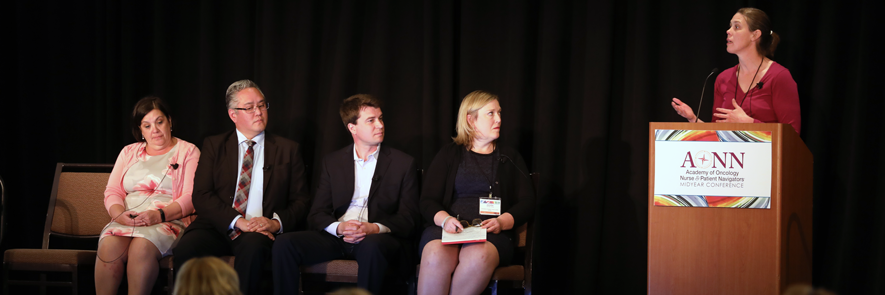
Jennifer R. Klemp, PhD, MPH, MA moderated a discussion on genetics and genomics, along with a panel of clinicians that included Andrey Antov, PhD, MBA; Frank dela Rama, RN, MS, AOCNS, AGN-BC; Sandra Neptune, RN, BSN; and Kate Reed, MPH, ScM, CGC.
Using the landmark discovery of the BRCA1 gene in determining genetic predisposition to breast cancer as an example, Dr Klemp discussed the difference between germline and somatic genetic variants. Germline mutations are inherited from parents and are present in reproductive cells, whereas somatic mutations are acquired by the patient and are present only in the tumor cells, said Dr Klemp, Associate Professor of Medicine, Division of Clinical Oncology, Director of Cancer Survivorship, and Co-Program Leader for Cancer Prevention and Survivorship at the University of Kansas Cancer Center, Kansas City.
Just as the 2 types of genetic variations differ, so do the testing processes for each. In somatic testing, tumor boards conduct a multidisciplinary review and interpretation of test results. In testing for germline genetic variants, patients receive genetic counseling before and after the test is performed to help them understand their personal risk for developing cancer and potential treatment options, as well as to obtain and analyze family histories. These 2 testing processes are likely to be combined in the near future, according to Dr Klemp, who, along with serving on a number of national boards, is a member of the AONN+ Leadership Council, where she serves as the Co-Program Chair for the Survivorship Committee and the Co-Chair for the AONN+ Nurse Navigator Certification on Genetic and Genomic Testing.
Not only can genomic information have a profound impact on the process of diagnosing patients by increasing diagnostic specificity, it can also affect each step of a patient’s journey through the treatment and posttreatment stages, as well. Genomics plays a vital role in decisions and outcomes throughout the care trajectory, helping to inform prognosis and provide information about the need for adjuvant therapy, according to Dr Klemp.
Genomics can be used after initial treatment in a number of ways. If a hereditary cancer syndrome is identified, the finding will inform screening, as well as potential options for preventing recurrence or development of a second primary cancer. In addition, the identification of a hereditary cancer syndrome provides the opportunity for cascade screening, testing close relatives for the variant causing the syndrome. Liquid biopsy can be used to monitor for cancer recurrence by analyzing a blood sample for genomic variants associated with a certain cancer type. If a large-panel genomic test has identified actionable variants for targeted therapies, those therapies may be options for treatment in the case of recurrence.
Despite the wealth of benefits gleaned from using genomic information to guide cancer care, it also comes with some challenges. First, because the field is relatively new, it’s important to realize that genomic information is only as good as the existing knowledge base, Dr Klemp said. Tests can reveal variants of unknown significance, for which clinical data are limited. In addition, tumor heterogeneity brings into question the reliability of the results of existing tests. In addition, she said, genomic information is only as good as the ability to use it. Issues of the accessibility of targeted therapies, off-label drugs, and clinical trials for patients make the practical value of genomic information questionable in a real-world setting.
Dr Klemp closed by offering attendees the opportunity to learn more and earn Continuing Nursing Education credits by visiting www.jax.org/cepm.
Integrative Medicine May Provide Improved Outcomes for Surgical Patients
Having surgery is a stressful endeavor. This is especially true for patients with a cancer diagnosis, who are contending with a host of issues and challenges related to their disease. The majority of patients with early-stage cancers will undergo some type of surgical intervention as part of their care, according to Rosanne Sheinberg, MD, Assistant Professor of Anesthesiology and Critical Care Medicine at the Johns Hopkins University School of Medicine, Baltimore, MD.
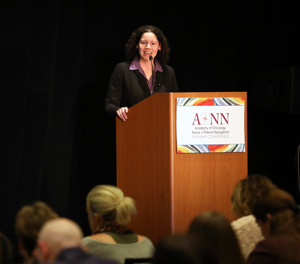
During a presentation, Dr Sheinberg explained how using integrative medicine that includes self-care, as well as complementary and alternative medicine (CAM), can enhance perioperative safety, comfort, and recovery while minimizing the side effects of anesthesia and surgery.
Health status prior to surgery is a major factor in patient outcomes. Despite leading the pack among other countries in healthcare spending, the United States lags behind when it comes to health and life expectancy. When examining what comprises overall health, medical treatments make up a mere 15% to 20%. Environment plays a small role as well, but the larger determinants of health are behavior and lifestyle factors (such as tobacco, alcohol, and drug use; diet and exercise; sexual activity; sleep; and stress), along with social and economic elements (such as education; employment; income; family and social support; and safety).
With these factors in mind, it is advisable to approach patient care with a broader scope, considering patients’ mind, body, and spirit in combining conventional and complementary methods to facilitate the body’s innate healing response through the use of less invasive therapies, said Dr Sheinberg, who is board certified in integrative medicine. This approach requires a partnership between the patient and practitioner, which empowers the patient to take control of his/her wellness and provides the practitioner with an opportunity to become a model of health and healing.
Key concerns on the part of practitioners whose patients are having surgery are avoiding adverse events; mitigating anxiety; controlling pain with minimal use of opioids; controlling nausea and vomiting; normal bowel and bladder function; and recovery and wound healing, Dr Sheinberg said. A comprehensive, patient-centered approach to treating these patients incorporates psychological preparation; perioperative nutrition; nonpharmacologic management of pain, as well as nausea and vomiting; promotion of sleep in the hospital setting; and strategies for recovery.
It is well known that distress plays a pivotal role in patient outcomes by influencing physiological responses or lack thereof. Stress reduction, therefore, is an integral part of preparation for surgery and recovery. Techniques for reducing stress include breath work, guided imagery, biofeedback, meditation, and clinical hypnosis, for which some research indicates is beneficial for patients.
Even more evidence exists to confirm the benefits of acupuncture, according to Dr Sheinberg. The National Institutes of Health (NIH) has called it an effective treatment for both postoperative and chemotherapy-induced nausea and vomiting, as well as postoperative dental pain. The NIH also deemed acupuncture a viable treatment for pain management in various conditions, among other indications. Several studies also support the role of acupuncture in reducing postoperative pain.
Other evidence-based therapies for pain management include chiropractic, osteopathic, and myofascial manipulation; massage; physical therapy; cognitive behavioral and other psychological therapies; mind–body approaches, such as meditation, biofeedback, and guided imagery; and yoga, tai chi, and other movement therapies, Dr Sheinberg said.
Also important to consider in implementing CAM therapies for surgical patients is perioperative nutrition, which includes not only foods consumed and fasting, but also the use of botanicals and dietary supplements. Aromatherapy can also play a role in addressing the mind–body connection for these patients.
Practitioners seeking more information about how to incorporate CAM therapies into the armamentarium for their patients can visit the website of the Society of Integrative Oncology at integrativeonc.org.
AONN+ is committed to helping oncology navigators enhance their professional development through a number of ways, including facilitating educational sessions and certification exams, and providing opportunities to network with peers at conferences. The AONN+ Ninth Annual Navigation & Survivorship Conference will take place on November 15-18, 2018, in Dallas, TX. Register today!


